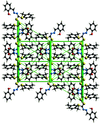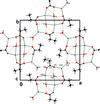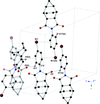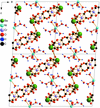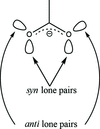issue contents
August 2020 issue

Cover illustration: Copper(I) iodide complexes show a wide variety of structural properties. One of the five reported crystal structures of such complexes with 6-thioxopiperidin-2-one (SNO) displays new polymeric sheets based on fused [Cu3I3] six-membered rings with a screw-boat conformation. Parallel sheets are connected by SNO ligands interacting by N-H O hydrogen bonds. See: Wheaton, Guzei & Berry [Acta Cryst. (2020). E76, 1336-1344].
O hydrogen bonds. See: Wheaton, Guzei & Berry [Acta Cryst. (2020). E76, 1336-1344].
research communications
Download citation


Download citation


In the crystal, face-to-face π-π stacking interactions occur along the a-axis direction between the centroids of the 2,6-dichlorophenyl ring and the nitro-substituted benzene ring. In addition, these molecules show intramolecular N—H⋯Cl and C—H⋯O contacts and are linked by intermolecular N—H⋯O and C—H⋯Cl hydrogen bonds, forming pairs of hydrogen-bonded molecular layers parallel to (20 ).
).
CCDC reference: 2012294
Download citation


Download citation


The structures of five 4-(4-fluorophenyl)piperazin-1-ium salts of closely related aromatic acids all show different patterns of supramolecular assembly.
Download citation


Download citation


Five azetidin-2-ones are described based on the 1-(3,4,5-trimethoxyphenyl)azetidin-2-one core with different substituents on the lactam 3 and 4 positions: (1) 3-(4-fluorophenyl)-4-(4-methoxyphenyl); (2) 3-(furan-2-yl)-4-(4-methoxyphenyl); (3) 3-(naphthalen-1-yl)-4-(4-methoxyphenyl); (4) 3-(3,4-dimethoxyphenyl)-4-(4-methoxyphenyl); (5) 4,4-bis(4-methoxyphenyl)-3-phenyl-1-(3,4,5-trimethoxyphenyl)azetidin-2-one.
Download citation


Download citation


The title compound crystallizes in the orthorhombic space group Pbca. The phenol ring is inclined to the benzonitrile ring by 25.65 (3)°. The configuration about the C=N bond is E, stabilized by a strong intramolecular O—H⋯N hydrogen bond that forms an S(6) ring motif.
CCDC reference: 2013269
Download citation


Download citation


The structures of the hydrofumarate salts of two N,N-dimethyltryptamine (DMT) derivatives, the synthetic psychedelics N-ethyl-N-propyltryptamine (EPT) and N-allyl-N-methyltryptamine (MALT), are reported.
Download citation


Download citation


The binary hexagonal intermetallic, La24Ru11, was synthesized and the structure determined as part of a study of the rare-earth-rich part of the La–Ru system.
CCDC reference: 2012571
Download citation


Download citation


In the title compound, the dihedral angle between the fused pyrazole and pyridine rings is 1.76 (7)°. The benzene and methoxy phenyl rings make dihedral angles of 44.8 (5) and 63.86 (5)°, respectively, with the pyrazolo[3,4-b] pyridine moiety. An intramolecular short S⋯O contact [3.215 (2) Å] is observed. The crystal packing features C—H⋯π interactions.
CCDC reference: 2005976
Download citation


Download citation


The metallacrown complexes DyIIINa(3-OHben)4[12-MCMn(III)N(shi)-4](H2O)4·10DMA, 1, and DyIIINa(4-OHben)4[12-MCMn(III)N(shi)-4](H2O)4·4DMF, 2, where MC is metallacrown, shi3− is salicylhydroximate, 3-OHben is 3-hydroxybenzoate, DMA is N,N-dimethylacetamide, 4-OHben is 4-hydroxybenzoate, and DMF is N,N-dimethylformamide, consist of a macrocyclic molecule with an [MnIII—N—O] repeat unit. For both 1 and 2, a DyIII ion is captured on the convex side of the central cavity, while a Na+ ion is captured on the concave side of the cavity. Four 3-hydroxybenzoate or 4-hydroxybenzoate anions bridge between the ring MnIII ions and the central DyIII ion.
Download citation


Download citation


The title morpholinochlorin adopts a ruffled conformation of its porphyrinic π-system chromophore inducing a red-shift of its optical spectrum compared to its chlorin analog.
CCDC reference: 2013871
Download citation


Download citation


The conformational trimorphism of a chiral amide is described, in space groups P21 and P212121, with different orientations of the supramolecular one-dimensional structures with respect to the twofold screw axis.
Download citation


Download citation


The 5-bromopentyl chain is oriented so that the bromine atom is ca 4.4 Å from one of the methyl C atoms of the dimethylamino group. In the crystal, two sets of inversion-related C—H⋯π(ring) interactions form stacks of molecules extending along the a-axis direction.
CCDC reference: 2013416
Download citation


Download citation


In the title unsymmetrical tertiary amine, which arose from the ring-opening reaction of a dihydrobenzoxazine, two 2,4-dimethylphenol moieties are linked by a 6,6′-(cyclohexylazanediyl)-bis(methylene) bridge: the dihedral angle between the phenol rings is 72.45 (7)°. The cyclohexyl ring adopts a chair conformation with the exocyclic C—N bond in an equatorial orientation.
CCDC reference: 2014264
Download citation


Download citation


The title hydrazine carbodithioate derivative is highly twisted as seen in the C—S—S—C torsion angle of 90.70 (8)°; the molecule is twofold symmetric. In the molecular packing, molecules are assembled into supramolecular layers in the ab plane by methylene-C—H⋯π(tolyl) interactions.
CCDC reference: 2013050
Download citation


Download citation


In the crystal of the title compound, the molecules are associated into inversion dimers via short Cl⋯Cl halogen bonds.
CCDC reference: 2014419
Download citation


Download citation


The crystal structure of a solid solution of ethyl and d3-methyl 2-[(4-methylpyridin-2-yl)amino]-4-(pyridin-2-yl)thiazole-5-carboxylate is reported.
CCDC reference: 2013452
Download citation


Download citation


The crystal structures of two coordination compounds of N-benzoylglycine, viz. catena-poly[[[diaquabis(N-benzoylglycinato)cobalt(II)]-μ-aqua] dihydrate], {[Co(C9H8NO3)2(H2O)3]·2H2O}n, and catena-poly[[[diaquabis(N-benzoylglycinato)nickel(II)]-μ-aqua] dihydrate], {[Ni(C9H8NO3)2(H2O)3]·2H2O}n, are described.
Download citation


Download citation


The FeII atom in the title complex, [Fe{H2B(3,5-(CH3)2-pz)(pypz)}2] (pz = pyrazole, pypz = pyridylpyrazole), is coordinated by two tridentate {H2B(pz)(pypz)}− ligands in form of a distorted N6 octahedron.
CCDC reference: 2014411
Download citation


Download citation


In the crystal, molecules of the title compound, a potential ligand containing two 8-quinolinol and one 2-pyridine units, are linked by intermolecular O—H⋯N and O—H⋯O quadruple hydrogen bonds, forming an inversion dimer with two  (7) ring motifs. The dimers are associated through a C—H⋯O hydrogen bond and four C—H⋯π interactions.
(7) ring motifs. The dimers are associated through a C—H⋯O hydrogen bond and four C—H⋯π interactions.
CCDC reference: 2014831
Download citation


Download citation


Silver(I) 3-carboxybenzenesulfonate, Ag(O3SC6H4CO2H), has been found to undergo a reversible phase transition from monoclinic to triclinic between 160 and 150 K. The low-temperature triclinic structure (space group P ) has been determined at 100 K.
) has been determined at 100 K.
CCDC reference: 2015332
Download citation


Download citation


The packing of the title molecular salt, in which the tin atom lies on a crystallographic inversion centre, is dominated by N—H⋯Cl hydrogen bonds.
CCDC reference: 1904730
Download citation


Download citation


A linear gold-atom geometry defined by phosphane-P and thiolate-S atoms is found in the title compound. The packing is stabilized by a combination of fluorobenzene-C—H⋯O(methoxy), phenyl-C—H⋯F, phenyl-C—H⋯S(thiolate) and phenyl-C—H⋯π(fluorobenzene, phenyl) interactions to generate a three-dimensional network.
CCDC reference: 2015568
Download citation


Download citation


In the crystal, face-to-face π-π stacking interactions along the a-axis direction occur between the 2,6-dichlorophenyl ring and nitro-substituted benzene ring of the title molecule. The molecules are further linked by C—H⋯O contacts and N—H⋯O and C—H⋯Cl hydrogen bonds, forming pairs of hydrogen-bonded molecular layers parallel to (100).
CCDC reference: 2015528
Download citation


Download citation


The asymmetric unit of the title compound, C11H12N2O2·H2O, contains a disordered molecule of 1,4,6-trimethyl-1,4-dihydro-quinoxaline-2,3-dione and a solvent water molecule. In the crystal, molecules are linked by O—H⋯O and C—H⋯O hydrogen bonds into layers lying parallel to (10 ). The Hirshfeld surface analysis is carried out.
). The Hirshfeld surface analysis is carried out.
CCDC reference: 1936663
Download citation


Download citation


The synthesis, crystal structure and physical properties of a novel one-dimensional zigzag chain-like CoII coordination polymer, [Co2(2-OHbenz)4(4,4′-bpy)2.5(H2O)]n, constructed from 4,4′-bipyridine (4,4′-bpy) and 2-hydroxybenzoate (2-OHbenz) are reported.
CCDC reference: 2015747
Download citation


Download citation


Caesium propanoate monohydrate is composed of two symmetry-independent Cs+ cations, which are situated on special position 4e, one symmetry-independent propanoate molecule in a general position and a pair of water molecules also situated on special position 4e. Two pairs of these symmetry-independent cations, four propanoate molecules and two pairs of symmetry-independent water molecules form a repeat unit, which gives rise to columns running along the c-axis direction. These columns are held together by intermolecular Ow—H⋯Op (w = water, p = propanoate) hydrogen bonds of moderate strength, and other pairs of moderate intramolecular hydrogen bonds reinforce the cohesion within the columnar unit.
CCDC reference: 2016565
Download citation


Download citation


The Diels–Alder cycloaddition of cycloheptatriene and maleic anhydride produces the title carboxylic anhydride; reaction of this anhydride with 4-bromophenylaniline forms the corresponding tetracyclic imide. The anhydride features C—H⋯O hydrogen bonds in the solid state, while the imide also features C—H⋯O hydrogen bonds as well as C—H⋯π and lone pair–π interactions.
Download citation


Download citation


The structure of the title compound is made up of corrugated anionic layers of formula [BaCr(C2O4)3(H2O)3]nn– that leave voids accommodating the charge-compensating cations, [Ni(H2O)6]2+ (point group symmetry  ), as well as the water molecules of crystallization.
), as well as the water molecules of crystallization.
CCDC reference: 1953456
Download citation


Download citation


In the title Schiff base compound, the hydroxy group forms a intramolecular hydrogen bond to the imine N atom generating an S(6) ring motif. The 3-chlorobenzene ring is inclined to the phenol ring by 9.38 (11)°. The configuration about the C=N bond is E.
CCDC reference: 2015356
Download citation


Download citation


The title compound, C15H12F3NO, crystallizes with a single molecule in the asymmetric unit. The phenol ring makes a dihedral angle of 44.77 (3)° with the benzene ring of the trifluoromethyl group. In the crystal, molecules are linked by C—H⋯O interactions, forming polymeric chain along the b-axis direction.
CCDC reference: 2016363
Download citation


Download citation


The title compound, C6H11NO2·2H2O2, is the richest (by molar ratio) in hydrogen peroxide among the peroxosolvates of aliphatic α-amino acids. Unusually for aliphatic α-amino acid peroxosolvates, the H2O2 molecules are linked, forming infinite hydrogen-bonded hydroperoxo chains running along the c-axis direction.
CCDC reference: 2016846
Download citation


Download citation


Five copper(I) iodide coordination compounds were synthesized and characterized by single-crystal X-ray diffraction measurements; the resulting structures display a diverse array of structural features.
Download citation


Download citation


The crystal of structure of (1,10-phen-H)[WOF5], a rare example of a [WOF5]− salt in which the oxygen and fluorine atoms are ordered, is reported.
CCDC reference: 2016898
Download citation


Download citation


A symmetrical dicarbonohydrazide was used to synthesize a centrosymmetric tetranuclear zinc(II) complex in which two of the zinc cations are pentacoordinated and the other two are hexacoordinated.
CCDC reference: 2011426
Download citation


Download citation


A known N-heterocyclic carbene precursor, zwitterionic 3,3′-[1,1′-(butane-1,4-diyl)bis(1H-imidazol-3-ium-3,1-diyl)]bis(propane-1-sulfonate) crystallized as its dihydrate and was characterized by single-crystal X-ray diffraction, revealing point group symmetry  for the zwitterionic molecule.
for the zwitterionic molecule.
CCDC reference: 2017141
Download citation


Download citation


The solid-state structures of two quaternary tryptammonium salts, N,N-dimethyl-N-n-propyltryptammonium (DMPT) iodide and N-allyl-N,N-dimethyltryptammonium (DMALT) iodide are reported.
Download citation


Download citation


In the title quinoxaline molecule, the dihedral angle angle between the benzene rings is 72.54 (15)°. In the crystal, molecules are connected into chains extending parallel to (10 ) by weak C—H⋯O hydrogen bonds.
) by weak C—H⋯O hydrogen bonds.
CCDC reference: 1936664
Download citation


Download citation


The crystal exhibits weak intramolecular π–π interactions between the phenyl rings. In the crystal, molecules are linked via pairs of C—H⋯ O, forming inversion dimers. The dimers are further linked by pairs of C—H⋯π interactions, forming infinite chains along the c-axis direction.
CCDC reference: 2017791
Download citation


Download citation


The title compound crystallizes in the alluaudite structure type. Its three-dimensional framework includes channels in which partially occupied sodium cations are situated.
CCDC reference: 2018562
Download citation


Download citation


The title compound consists of discrete complexes with the composition Co(NCS)2(tetramethylthiourea)2, in which the CoII cations are tetrahedrally coordinated by two N-bonded thiocyanate anions and two tetramethylthiourea ligands. These complexes are linked by intermolecular C—H⋯S hydrogen bonds into layers that are parallel to the ab plane.
CCDC reference: 2018676
Download citation


Download citation


The two [3.3.1] metallacryptate complexes [DyAl6Na5(OAc)(Hshi)2(shi)7(DMF)8]·H2O·4DMF, 1, and [DyAl6Na5(OAc)(Hshi)2(shi)7(DMF)8.5]2·6.335DMF, 2, where shi3− is salicylhydroximate and DMF is N,N-dimethylformamide, both consist of an aluminium-based metallacryptand. In 1 and 2, the metallacryptand encapsulates a dysprosium(III) ion in the central cavity, and the resulting metallacryptates are connected to each other to generate a two-dimensional sheet.
Download citation


Download citation


The crystal structures of DIN and TBT were determined by X-ray diffraction at 150 K. In the crystal of DINT, molecules are linked via short N—O⋯I contacts, forming chains along [100]. In TBT, molecules are linked by C—H⋯Br hydrogen bonds, forming chains along [010].
Download citation


Download citation


Each of the two unique metal complex molecules in the title compound shows a distorted N6 coordination set defined by three pairs of chelating ligands.
CCDC reference: 2019452
Download citation


Download citation


The title ferrocene derivative including an alkyne and a para-nitrophenyl substitution crystallizes in the P21/n space group. In the ferrocene unit, the pentadienyl (Cps) rings are in an eclipsed conformation. Strong intermolecular π–π-stacking, CH(Cp)—C(Cp), and O(p-nitrophenyl)—HC(Cp) interactions consolidate the crystal structure.
CCDC reference: 1991635


 journal menu
journal menu























